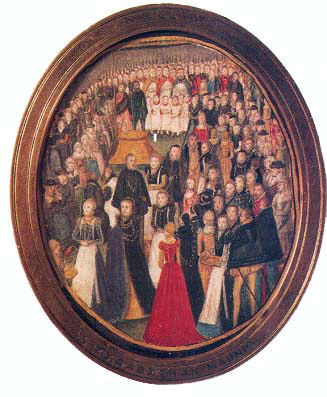Today, in the Western Christian Church, is Good Friday, which, of course, commemorates the crucifixion of Jesus Christ. I'm going to mark the dat by sharing how the day was commemorated in Tudor times.
But first, here is the account of Christ's crucifixion from John's Gospel. I've chosen the 16th century Tyndale Bible:
"And he bare his crosse and went forthe into a place called the place of deed mens sculles which is named in Hebrue Golgatha. Where they crucified him and two other with him on ether syde one and Iesus in the myddes. And Pylate wrote his tytle and put it on the crosse. The writynge was Iesus of Nazareth kynge of the Iewes. This tytle reed many of the Iewes. For the place where Iesus was crucified was nye to the cite. And it was written in Hebrue Greke and Latyn. Then sayde the hye prestes of ye Iewes to Pylate: wryte not kynge of the Iewes: but that he sayde I am kynge of the Iewes. Pylate answered: what I have written that have I written.
Then the soudiers when they had crucified Iesus toke his garmentes and made foure partes to every soudier a parte and also his coote. The coote was with out seme wrought vpon thorowe out. And they sayde one to another. Let vs not devyde it: but cast loostes who shall have it That the scripture myght be fulfilled which sayth. They parted my rayment amonge them and on my coote dyd cast lottes. And the soudiers dyd soche thinges in dede.
Ther stode by the crosse of Iesus his mother and his mothers sister Mary the wyfe of Cleophas and Mary Magdalene. When Iesus sawe his mother and the disciple stondynge whom he loved he sayde vnto his mother: woman beholde thy sonne. Then sayde he to ye disciple: beholde thy mother. And fro that houre the disciple toke her for his awne. After that when Iesus perceaved that all thinges were performed: that the scripture myght be fulfilled he sayde: I thyrst. Ther stode a vessell full of veneger by. And they filled a sponge with veneger and wounde it about with ysope and put it to his mouth. Assone as Iesus had receaved of the veneger he sayd: It is fynesshed and bowed his heed and gaue vp the goost.
The Iewes then because it was the saboth eve that ye bodyes shuld not remayne apon ye crosse on ye saboth daye (for that saboth daye was an hye daye) besought Pylate that their legges myght be broken and that they myght be taken doune. Then came the soudiers and brake the legges of the fyrst and of the other which was crucified with Iesus. But when they came to Iesus and sawe that he was deed already they brake not his legges: but one of the soudiers with a speare thrust him into the syde and forthwith came ther out bloud and water. And he that sawe it bare recorde and his recorde is true. And he knoweth that he sayth true that ye myght beleve also. These thinges were done that the scripture shuld be fulfilled: Ye shall not breake a boone of him. And agayne another scripture sayth: They shall looke on him whom they pearsed.
After that Ioseph of Aramathia (which was a disciple of Iesus: but secretly for feare of ye Iewes) besought Pylate that he myght take doune the body of Iesus. And Pylate gave him licence. And ther cam also Nicodemus which at the beginnynge came to Iesus by nyght and brought of myrre and aloes mingled to gether aboute an hundred pounde wayght Then toke they the body of Iesu and wounde it in lynnen clothes with the odoures as ye maner of the Iewes is to bury. And in the place where Iesus was crucified was a garden and in ye garden a newe sepulchre wherin was never man layd. There layde they Iesus because of the Iewes saboth even for the sepulcre was nye at honde." (John 19: 17-42)
In medieval and Tudor times, and in some churches today, Good Friday was the day to prepare the Easter Sepulchre. The sepulchre consisted of a stone or wooden niche, representing Christ's sealed tomb, which was filled with the consecrated host and an image of Christ. Once this was 'sealed' by covering it with a cloth, candles were lit around it, and members of the church would guard it just as the Roman soldiers had done when the body of Christ was sealed in the cave. People also attended a special church ceremony known as 'creeping to the cross'. Christ's suffering and crucifixion, and what it meant, were commemorated by the clergy creeping up to a crucifix held up before the altar on their hands and knees. When they got to the crucifix, they would kiss the feet of Christ. The crucifix was then taken down into the church for the congregation to do the same.
In Edward VI's reign, the ceremony of creeping to the cross was abolished. However, the ceremony was resurrected in Mary I's reign and cramp rings were also blessed with holy water and distributed to sufferers of epilepsy and cramps, and Mary also touched for the king's evil. It was believed that monarchs had the divine gift of healing and that by touching or stroking the neck of someone with scrofula, a type of tuberculosis, they could heal the sufferer. The sufferer could also be given a touch-piece, a coin, such as an angel coin, that was blessed by the monarch and which could be pressed to their neck.
Creeping to the cross and the blessing of cramp rings was not done in Elizabeth's reign, but Elizabeth did touch for scrofula on certain feast days.
Usually, in my neighbouring town here in Spain, Good Friday is marked by a dawn Good Friday (Viernes Santo) procession. This annual procession starts at the town church and makes its way up to "Calvario" (Calvary), the hill behind the town on which there is a big wooden cross. We process with a big statue of Jesus carrying his cross and also a replica of Jesus actually on the cross. As we make our way up the hill, we pause at each of the 12 stations of the cross for a reading and prayers. When we reach the cross, the replica of Jesus on the cross is hoisted up onto it. Later in the day, there is another service and procession when Jesus is taken down off the cross. I did a video on it a couple of years ago:



Leave a Reply